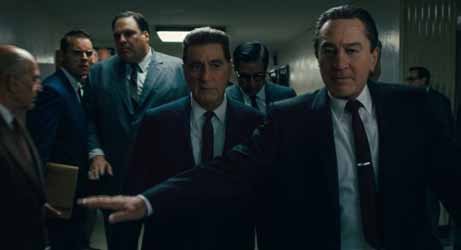|
Click here to return to the main site. Movie Review
I make the case that the significance of The Irishman will influence all film and exhibition forever. The movie draws on the best tech most prominent in several genres, but transcends comic book plots with a dose of meaningful classicism which, in truth, is no stranger to the greatest of super hero movies. It looks squarely at the struggle between good and evil and leaves viewers to contemplate their own answers for the attractiveness of evil and the perceived weakness of good, indeed asking what is good? Forget God, what in a godless world, is good? Are heroes even possible beyond Comic-Con consciousness or is justice league nobility strictly a CGI buffered wank?
First, the technical foundation. The Irishman should be of interest to all fans of special effects, practical and CGI, because of its state of art application and deep seated diligence. Disney and ILM are the wizards behind the curtain here for face capture that exceeds all previous forays in the field. Anyone with a passion for such matters should be aware of the penultimate journal on the subject, Cinefex and its now available edition dealing with the digital prowess of The Irishman. (cinefex.com). If you’re a declared fan of efx tech and not aware of Cinefex then you are culturally deprived and perhaps should pursue other interests in life like wood whittling or the lute. Controversy has boiled over how this film should be seen. Theatrical big screen with an audience or in the comfort of your home crib and whatever size screen you have to receive the Netflix stream. You could watch it on an iPhone screen, laptop, desktop or your own HD boat sail. I urge you to go large. The bigger your home screen, the better. The more lucent your HD screen, the better. The test here is simple: would Lucifer watch this picture or consider it a goddamn photonic insult? Either you have the eyes to see (equal time here for Jesus) or Film Pilgrim, you don’t. With the larger screen your wandering eye will have more freedom to roam and orbit in the art of visual perception. A peanut shell screen will torture you with fractal frustration. The only way to watch The Irishman on a teensy weensy screen is to tape a microscope to your head. I do not think this will be a fad that finds traction.
form the parameters for how the bio-physics of our eyes ‘focalise’ and how our amygdala (our third eye) ‘cognises’ meaning from a two-dimensional frame. When that frame is a Panavision, a Techni-scope, any wide screen, we need a certain scale to appreciate it. To do this is to discover The Irishman as the most sophisticated CGI achievement in motion picture history. Much debate has ensued over the face capturing. Is it distracting? No. The acting is so good only a technician will see it. Gone are the days when James Cameron would slap Kabuki doll faces of Kate and Leonardo onto stunt doubles dashing down a Titanic corridor ahead of gushing water. Noticing the stunt doubles hardly matched the stars’ bodies didn’t help either. A lot of things have improved in the last two decades. One example from The Irishman: Freeze your Netflix stream at 2 hours and 45 minutes into the film. De Niro (Frank Sheeran, the Irishman) and Pacino (Jimmy Hoffa) sit beside each other in the back seat of a (rolling) car shot. The faces are from the actors’ middle age but they perform (no doubt with painstaking software diligence in each and every 24 frames (or more) per second. It’s humanly impossible to manage such a workload, that’s why a machine with artificial intelligence must do it. Oh, there is a person present and they do perform tasks but basically their job is to start the software engine, stay out of the way and not spill coffee on the keyboard. They do not have final approval on ‘the look’ either. They can show something they really really think is good or at least okay and be told by De Niro or Scorsese that it’s utter shit and to do it again. Herein is the nugget of the budget overrun controversy. Irishman is rumoured to have cost up to $200 million. Protective public relations winnowed this number down to $160 million and even a paltry $130 million.
All this technical virtuosity should not eclipse our respect for the hermeneutic value being served. Frank Sheeran is an ageing hit man who has trodden a blood spattered path through history and lived to tell about it. Sheeran is only alive now because he never talked, but here at the end of his days, in the nursing home, he’s talking. To us. It’s safe to tell us because nothing matters anymore. Here is Sheeran’s naked crisis of despair vs wisdom and wisdom is an icicle in his heart. A priest (an uncredited Father Jonathan Morris) will lead him through a childlike recitation of his catechetical confession but Frank will never tell what he’s confessing. What really happened. Only we get to know that. We get to be God. This aspiration to novelistic scope is why The Irishman is truly one of the greatest films ever made. It should give us all hope for the future of film. When Christopher Hitchens was approaching death, the renowned atheist warned people not to believe it if they heard he had recanted and come to the Lord in the eleventh hour. It would be, he warned, only delusion, courtesy of sister morphine or simply a lie told by bedside fundamentalist vampires, lunatic carpetbaggers shilling celestial life insurance. To be fair though to Frank Sheeran and his final ruminations, he probably shot more people in the face than any vaudeville atheist you can think of.
The Irishman is a re-watch movie, like Bach and Beethoven are re-listen music and Shakespeare is… well, you get what I’m saying. We don’t get many movies like this, these days or effing ever. It’s a crowning life work for all involved and it augers a new era for people, like Netflix, who love movies. I’d give it eleven out of ten stars if they’d let me. 10 John Huff
|
|---|
Click here to return to the main site.

 I will try to say here thoughts I haven’t read in sundry other reviews. That is difficult because praise for The Irishman has been consistently harmonious for what is Martin Scorsese’s most philosophical and reflective work in his lifetime of helming great films. An old man’s film, they say. Contemplative, meditative, introspective. These facile pronouncements have Gen-X consensualized hubba hubba writ all over them.
I will try to say here thoughts I haven’t read in sundry other reviews. That is difficult because praise for The Irishman has been consistently harmonious for what is Martin Scorsese’s most philosophical and reflective work in his lifetime of helming great films. An old man’s film, they say. Contemplative, meditative, introspective. These facile pronouncements have Gen-X consensualized hubba hubba writ all over them. ‘It is what it is’ becomes a repeated catchphrase in the elegant dialogue by master screenwriter Steven Zaillian. And it’s true as well for comprehending the visual riches of Scorsese’s frames concretized by cinematographer Rodrigo Prieto. Much is happening in the bread and butter macros as well as the two-shots and close ups. These are ‘Rembrantian’ exposures, commanding your visual immersion. The simple facts of art and visual perception (f.i., Rudolf Arnheim
‘It is what it is’ becomes a repeated catchphrase in the elegant dialogue by master screenwriter Steven Zaillian. And it’s true as well for comprehending the visual riches of Scorsese’s frames concretized by cinematographer Rodrigo Prieto. Much is happening in the bread and butter macros as well as the two-shots and close ups. These are ‘Rembrantian’ exposures, commanding your visual immersion. The simple facts of art and visual perception (f.i., Rudolf Arnheim  These face captures combined with motion control were the electrum shots, measured in gold and silver and their generated images serve the actors’ lifetime library of iconography. In the back seat shot, one can detect, or more accurately intuit, De Niro’s right cheek against the background through the rear window. There is no visible edge line per se but a near subliminal awareness of a differentiation, a seamless application. The same is true for Pacino. But one has to strain to see it because the combinate dramatic syntheses of both actors is so overpowering – the lifelikeness of these great faces with their soulful eyes drilling us from inside their artistic minds.
These face captures combined with motion control were the electrum shots, measured in gold and silver and their generated images serve the actors’ lifetime library of iconography. In the back seat shot, one can detect, or more accurately intuit, De Niro’s right cheek against the background through the rear window. There is no visible edge line per se but a near subliminal awareness of a differentiation, a seamless application. The same is true for Pacino. But one has to strain to see it because the combinate dramatic syntheses of both actors is so overpowering – the lifelikeness of these great faces with their soulful eyes drilling us from inside their artistic minds. Sheeran confesses to us that he killed Jimmy Hoffa, the best friend he ever had. He did it for ‘it is what it is’ and now as a dying old man can’t find closure, let alone the peace that passeth understanding. Sceptics and cynics will squirm at recognizing the real life Father Jonathan Morris ministering to him at the end. The priest’s loving attitude, his confidence in the power of God’s love, even for Frank, is the genuine article all the way. That Scorsese and De Niro asked Morris aboard is the most cunning piece of casting in the whole film. Yes, there are real mobsters all the way through and they’re beautiful because they’re real. But Morris is beautiful because he too is real. Morris acts with De Niro in real pain and compassion. If you’re going to be one-on-one with the great raging bull himself, agonizing in a private hell omertà, giving the finest performance of his life, you’re going to be air-lifted to dramatic sincerity because it is what it is.
Sheeran confesses to us that he killed Jimmy Hoffa, the best friend he ever had. He did it for ‘it is what it is’ and now as a dying old man can’t find closure, let alone the peace that passeth understanding. Sceptics and cynics will squirm at recognizing the real life Father Jonathan Morris ministering to him at the end. The priest’s loving attitude, his confidence in the power of God’s love, even for Frank, is the genuine article all the way. That Scorsese and De Niro asked Morris aboard is the most cunning piece of casting in the whole film. Yes, there are real mobsters all the way through and they’re beautiful because they’re real. But Morris is beautiful because he too is real. Morris acts with De Niro in real pain and compassion. If you’re going to be one-on-one with the great raging bull himself, agonizing in a private hell omertà, giving the finest performance of his life, you’re going to be air-lifted to dramatic sincerity because it is what it is.